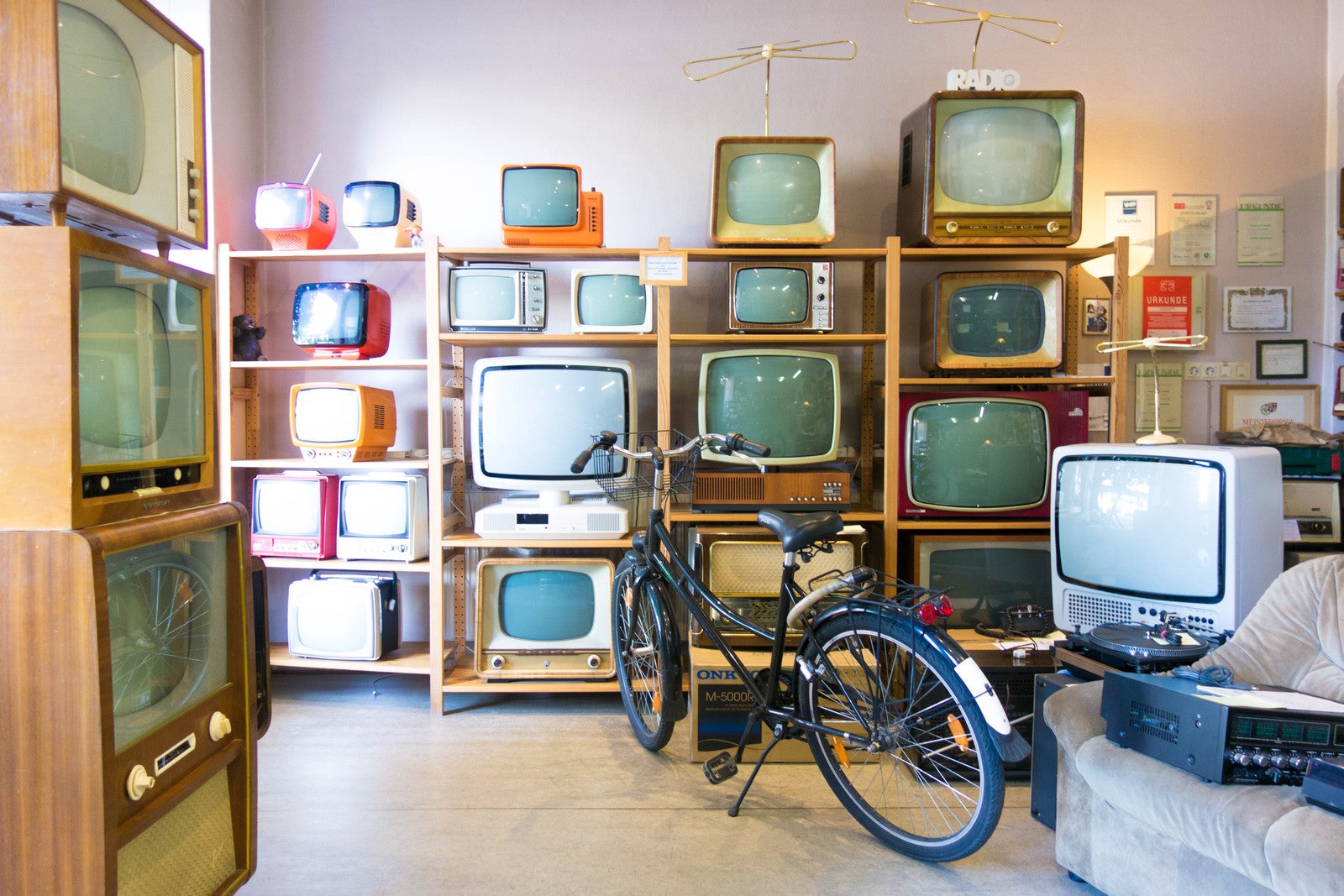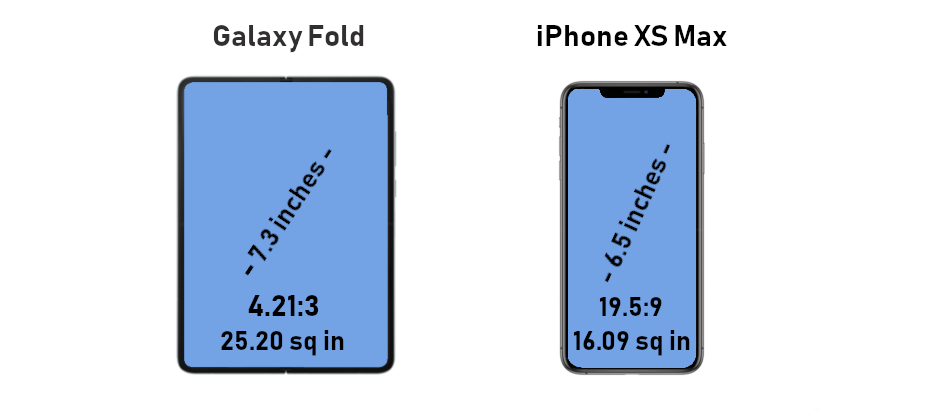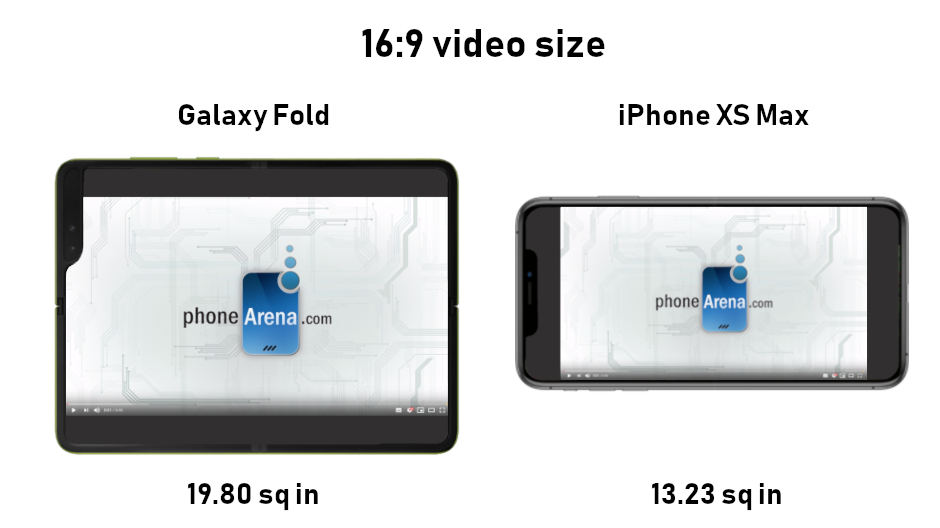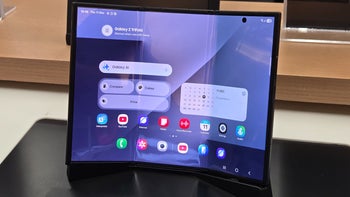The Galaxy Fold has a much bigger screen than its 7.3-inch diagonal suggests

Despite the turbulent arrival of the Samsung Galaxy Fold, it looks like foldable smartphones are here to stay, bound only to become more prevalent in the future, as prices drop and more brands enter the market. But as is usually the case when a new technology is introduced, its pros and cons may not be immediately obvious, obfuscated by new terms and misleading figures.
That’s why we decided to take a closer look at the main advantage of foldable smartphones: the unexpectedly large folding display. On paper, the 7.3-inch display on the Galaxy Fold might not seem like a huge bump over something like the iPhone XS Max and its 6.5-inch screen. In reality, however, the gains in screen area are quite significant.
We're used to screen size being expressed by the length of its diagonal in inches. It's a practice dating back to the era of old-school tube TVs – a simpler time when all screens were more or less of the same rectangular shape. And because they had the same shape, a screen's diagonal length was enough for one to get a clear idea of how big that screen was and how it compared to other screens.
Display diagonal is just half the story
We're used to screen size being expressed by the length of its diagonal in inches. It's a practice dating back to the era of old-school tube TVs – a simpler time when all screens were more or less of the same rectangular shape. And because they had the same shape, a screen's diagonal length was enough for one to get a clear idea of how big that screen was and how it compared to other screens.

Old-school TVs came in different sizes, but they all had the same roughly rectangular shape
The shape of a rectangular display is usually expressed by its aspect ratio. For example, a screen whose long side is twice as long as its short side has an aspect ratio of 2:1 (pronounced "2 to 1" or "2 by 1"). The same aspect ratio may be stated as 18:9 and it would basically mean the same thing. Following the same principle, if a screen's long side is 1.5 times longer than the short one, its aspect ratio would be 1.5:1 or 3:2. A square display would have an aspect ratio of 1:1 because its sides are all of the same length. Here are some aspect ratios common among smartphone displays:
- 16:9 - on older phones like the iPhone 8 and the Galaxy S7
- 19:9 - like on the Galaxy S10, for example
- 19.5:9 - seen on the iPhone XS and XS Max
Because display aspect ratios vary from one phone to another, the size of a display's diagonal is not an ideal representation of its overall size. Two screens with the same diagonal length but different aspect ratios – or vice versa –will have different areas.
Now let's go back to the above example. The Samsung Galaxy Fold has a 7.3-inch foldable display, a diagonal length only 12.3% greater than that of the 6.5-inch iPhone XS Max. However, the Galaxy Fold provides over 55% more screen area than the iPhone XS Max – and it's hard to realize this looking at diagonals alone.
Diagonals, aspect ratios and screen size

Even if square inches and percentages don't mean much to you, from the picture above it's obvious how big the difference is. True, the iPhone has a small handicap, but even if we bump its diagonal to 7.3-inches, the display area will reach 19.8 sq inches, still 20% less than that of the Galaxy Fold. The reason for that is the much "taller" aspect ratio of the iPhone. To match the area of the Galaxy Fold, the iPhone would need to have an 8.12-inch display.
Are foldable phones optimal for video watching?
But how good are those larger foldable displays when it comes to videos? Unfortunately, watching a typical 16:9 video on a phone like the Galaxy Fold will result in significant black bars. This is where regular smartphones gain back some of the lost ground. How much, exactly? Let’s see!

As expected, the bigger Galaxy Fold still holds a significant lead, displaying video across a 50% greater area. That’s without “stretching” the video to fill the display of the iPhone. If you opt to do that, you'll gain a few square inches but sacrifice parts of the video in the process, so we won't examine that scenario.
Since neither display's aspect ratio is exactly 16:9, both lose part of their areas to black bars. For the Galaxy Fold, this means black bars on the top and bottom, while for the iPhone, the bars show up on the sides. It should be noted that on the Galaxy Fold, the notch bites away part of the video (not shown in our graphic), while the iPhone's notch remains hidden in the black bars unless you choose to stretch the video. The Galaxy Fold has the option to shrink videos so that they don't extend beyond the edge of the notch, but this will cost you a few precious square inches of area.
- Galaxy Fold: 21.4% black bars, 6.81 inches video diagonal
- iPhone XS Max: 17.8% black bars, 5.56 inches video diagonal
Both devices lose about a fifth of their displays to darkness, with the Galaxy Fold being slightly ahead in that category as well. In terms of video size, the fold only lost half an inch of the total 7.3 inches, while the iPhone lost a whole inch.
Overall, the advantages of the Galaxy Fold's bigger display are unquestionable. You do get significantly more screen real estate for your browsing, gaming, and productivity needs. That's the case for video watching as well, although the gains aren’t as drastic. If YouTube is your main portal for entertainment, then a traditional plus-sized smartphone is more than enough to have a good experience. That is unless you want to be able to scroll through the comments while watching the video. In that case, the Galaxy Fold has no competition.
Follow us on Google News











Things that are NOT allowed:
To help keep our community safe and free from spam, we apply temporary limits to newly created accounts: